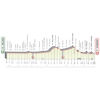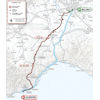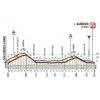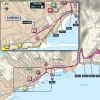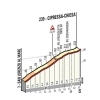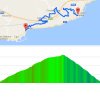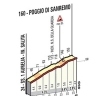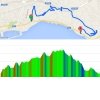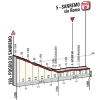Normally the route would have been a carbon copy of last year. But on 28 July the mayors of several towns along the hilly Ligurian coastline refused permission for the race to pass on their roads and the organisation acted fast and presented a new route from Milan tot San Remo. The race now heads southwest into Piemonte and moves through Alessandria and Nizza Monferrato before arriving at the foot of the climb to Niella Belbo.
One could argue that this is an alternative to the Passo Turchino. Both are tedious but far from steep. The Niella Belbo climb is 20 kilometres long and slopes at 2 to 3%.
As a matter of fact, Milan-San Remo serves two Passo Turchino’s, as the Colle di Nava is similar, although longer and even less steep with gradients hovering around 1 to 2%. The summit lies at an elevation of 936 metres and leads all the way down to Imperia on the Mediterranean Coast.
Imperia lies just after the Capo Mele, Capo Cervo and Capo Berta, so this combo won’t be incorporated into Milan-San Remo 2020. In fact, the section Imperia-San Remo is the only part of the original route that remains intact. It’s 40 kilometres long.
The route continues along the coast to the foot of the Cipressa. This ascent is 5.5 kilometres long and the average gradient sits at 4.1%. Usually, the sprinters are struggling on this climb, so BORA (Sagan), Alpecin (Van der Poel) and CCC (Van Avermaet, Trentin) will be motivated to keep the pace high.
With 20 kilometres remaining the peloton heads for the Poggio. The 3.7 kilometres climb averages 3.7%, which is not very impressive, but after almost 300 kilometres in the saddle it takes a huge effort for the bigger riders to get over at the front. The Poggio peaks out at 8% with 1 kilometre left to climb.
The last three editions saw decisive moves on the Poggio. Last year, Alaphilippe attacked inside the last kilometre of the climb and Sagan, Van Aert, Valverde, Naesen, Kwiatkowski and Trentin managed to cling on. The seven were the first riders over the Poggio before Dumoulin, Valverde, Nibali and Mohoric rejoined them in the descent. Alaphilippe outsprinted this elite group ahead of Naesen and Sagan.
Three years ago, Kwiatkowski, Sagan and Alaphilippe also attacked on the climb. Following a brilliant descent the race came down to a three-up sprint with the Pole taking the spoils. In 2018, Nibali opted for a similar scenario in solo style.
The last 2.35 kilometres of Milan-San Remo are flat and perfect for any sprinter who is still in the mix.
Another interesting read: results Milan – San Remo 2020.
Milan-San Remo 2020: route, profiles, more
Click on the images to zoom
